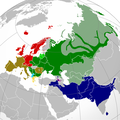Soubor:Indo-European branches map.png

Velikost tohoto náhledu: 599 × 600 pixelů. Jiná rozlišení: 240 × 240 pixelů | 479 × 480 pixelů | 767 × 768 pixelů | 1 023 × 1 024 pixelů | 2 045 × 2 048 pixelů | 2 934 × 2 938 pixelů.
Původní soubor (2 934 × 2 938 pixelů, velikost souboru: 2,16 MB, MIME typ: image/png)
Historie souboru
Kliknutím na datum a čas se zobrazí tehdejší verze souboru.
| Datum a čas | Náhled | Rozměry | Uživatel | Komentář | |
|---|---|---|---|---|---|
| současná | 26. 9. 2022, 05:43 |  | 2 934 × 2 938 (2,16 MB) | Alexikoua | minor fixes |
| 30. 3. 2022, 17:58 |  | 2 934 × 2 938 (1,74 MB) | Whoop whoop pull up | Whoops, wrong file! | |
| 30. 3. 2022, 17:37 |  | 2 048 × 2 048 (980 KB) | Whoop whoop pull up | Misc fixes (Russian minority in Svalbard & Israel, Slovenian in SE Carinthia, Greek in N Epirus, Aromanians/Megleno-Romanians, Swedish essentially extinct in Estonia, etc. | |
| 22. 12. 2021, 11:37 |  | 2 934 × 2 938 (1,74 MB) | Ahmet Q. | Reverted to version as of 19:55, 23 August 2021 (UTC)seek consensus for your changes | |
| 25. 11. 2021, 22:40 |  | 2 934 × 2 938 (2,16 MB) | Alexikoua | rv elimination of Greek minority in Albania | |
| 23. 8. 2021, 21:55 |  | 2 934 × 2 938 (1,74 MB) | Ahmet Q. | Rv false edit summary. Overrepresentation of Greeks in Turkey, Albania and Ukraine. Unexplained removal of Romanian in Serbia. Overall deterioration of the original file. Seek consensus for your changes. | |
| 7. 8. 2021, 18:16 |  | 2 934 × 2 938 (2,16 MB) | Demetrios1993 | Addition of Arbereshe linguistic minority in Sicily. Addition of Serbian, Bosnian, and Gorani linguistic minorities in Kosovo. Addition of Greek linguistic minorities in Italy, Albania, Turkey, and Ukraine. Including some other minor corrections. | |
| 19. 11. 2020, 19:00 |  | 2 934 × 2 938 (1,74 MB) | Golden | update Armenian | |
| 31. 3. 2018, 20:42 |  | 1 479 × 1 479 (574 KB) | Maphobbyist | Removed area that exactly corresponds to the non-Indo European Lezgi linguistic area. | |
| 6. 9. 2016, 23:37 |  | 1 479 × 1 479 (620 KB) | Rob984 | Georgia and Azerbaijan aren't majority multilingual. Older generations speak Russian from the Soviet era but now English is taught mainly in place of Russian. More people speak English in Finland, yet that isn't coloured. Also corrections to Celtic are... |
Využití souboru
Tento soubor používá následující stránka:
Globální využití souboru
Tento soubor využívají následující wiki:
- Využití na ast.wikipedia.org
- Využití na ban.wikipedia.org
- Využití na be-tarask.wikipedia.org
- Využití na be.wikipedia.org
- Využití na bg.wikipedia.org
- Využití na da.wikipedia.org
- Využití na de.wikipedia.org
- Využití na en.wikipedia.org
- Využití na en.wikiversity.org
- Využití na es.wikipedia.org
- Využití na et.wikipedia.org
- Využití na eu.wikipedia.org
- Využití na fa.wikipedia.org
- Využití na fi.wikipedia.org
- Využití na frr.wikipedia.org
- Využití na fr.wikipedia.org
- Využití na gl.wikipedia.org
- Využití na gu.wikipedia.org
- Využití na gv.wikipedia.org
- Využití na hak.wikipedia.org
- Využití na he.wikipedia.org
- Využití na hy.wikipedia.org
- Využití na hyw.wikipedia.org
- Využití na ilo.wikipedia.org
- Využití na incubator.wikimedia.org
- Využití na io.wikipedia.org
- Využití na it.wikipedia.org
Zobrazit další globální využití tohoto souboru.



